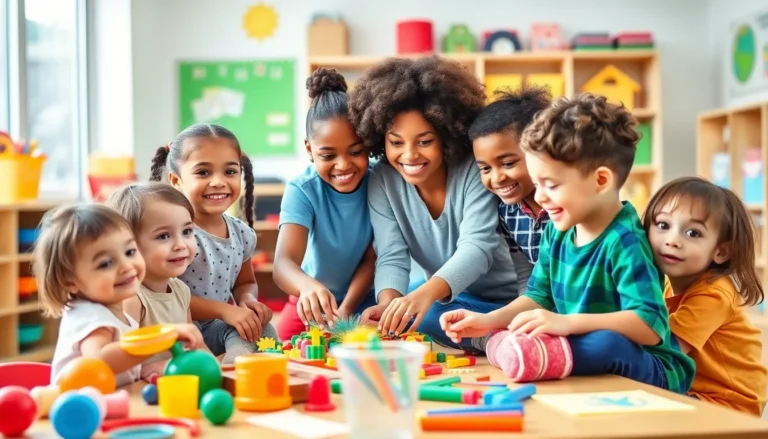Table of Contents
ToggleDivorce can feel like a chaotic circus, and kids often find themselves caught in the middle of the act. But what if there was a way to navigate this emotional rollercoaster with a little humor and a lot of heart? Enter “Don’t Divorce Me! Kids’ Rules for Parents on Divorce,” a refreshing take on how children view their parents’ separation. It’s not just a guide; it’s a survival manual for families aiming to keep the peace while juggling the ups and downs of divorce.
Overview of “Watch Don’t Divorce Me! Kids Rules for Parents on Divorce”
“Don’t Divorce Me! Kids’ Rules for Parents on Divorce” addresses the complex emotional landscape children navigate when parents decide to separate. This guide emphasizes understanding from the child’s perspective, offering practical advice for parents. Through humor and sincerity, it provides tools for fostering a positive environment during a challenging time.
Stocked with engaging illustrations, the book captures a child’s view on divorce, highlighting what children wish their parents knew. It encourages open dialogue between parents and children, emphasizing the importance of listening. Parents gain insight into how their actions impact their children, promoting mindful choices during separation.
Illustrating vital rules to follow, the book outlines strategies that help maintain stability and ensure children feel supported. Emphasis on respect and cooperation between parents remains crucial, as it shapes children’s emotional responses. Careful attention to communication helps prevent misunderstandings and emotional distress.
Real-life examples further enhance understanding, making concepts relatable and applicable. Parents find guidance in addressing their children’s concerns and fears. This text serves as both a humorous anecdote and a serious toolkit for navigating one of life’s toughest challenges.
Ultimately, “Don’t Divorce Me! Kids’ Rules for Parents on Divorce” strives to create a space where kids can process their feelings in a supportive setting. By emphasizing empathy, the book encourages parents to prioritize their children’s well-being, leading to healthier family dynamics during and after divorce.
Key Themes Explored in the Series
“Don’t Divorce Me! Kids’ Rules for Parents on Divorce” highlights critical issues impacting children during their parents’ separation. This series explores their emotional challenges and offers insights and practical solutions for families.
Impact of Divorce on Children
Divorce creates emotional turmoil for kids. Fear, confusion, and sadness often accompany their experiences. Many children feel torn between parents and worry about family stability. It’s vital for parents to recognize these feelings and address them openly. Effective communication can alleviate fears and provide reassurance. Research indicates that children’s well-being relies heavily on their parents’ emotional responses and support systems. Creating a safe space for open discussions empowers children to express their emotions. Understanding that their needs matter significantly impacts their adjustment.
Strategies for Effective Co-Parenting
Effective co-parenting creates a nurturing environment for children post-divorce. Respectful communication between parents plays a crucial role in preserving children’s emotional health. Setting clear boundaries helps establish stability in their lives. Consistent routines also contribute to a sense of security for kids. Collaborative decision-making shows children that both parents are united in supporting their well-being. Sharing responsibilities fosters cooperation and minimizes conflict. Developing strategies to manage disagreements constructively is essential. Prioritizing relationships amongst co-parents ultimately leads to healthier interactions for everyone involved.
Insights from Expert Commentary
Experts weigh in on the challenges children face during divorce. Their insights ensure parents understand children’s emotional needs throughout the process.
Child Psychologists’ Perspectives
Child psychologists emphasize the importance of stability during parental separation. They suggest that consistent routines help ease children’s anxiety. Open communication is vital, as children need reassurance that both parents love them. Experts highlight that humor can defuse tense situations, making discussions easier. Encouraging children to express their feelings prevents misunderstandings. Psychologists also note that respectful co-parenting creates a supportive atmosphere, allowing children to feel secure. Ultimately, creating a nurturing environment significantly benefits children’s emotional well-being during divorce.
Real-Life Parent Testimonials
Parents share personal stories about navigating the challenges of divorce with their children. One parent notes that actively listening to their child’s feelings helped build trust. Another emphasizes the value of maintaining family traditions despite the separation. Many parents report that using the guide’s rules fostered better communication with their ex-partner. Testimonials reveal that prioritizing children’s emotions promotes healthier family dynamics. Parents are encouraged to collaborate on decisions, emphasizing the child’s needs. Through shared experiences, these testimonials illustrate that understanding children’s perspectives leads to smoother transitions during difficult times.
Practical Tips for Parents
Effective parenting during a divorce requires thoughtful strategies. These approaches help children navigate their emotions and maintain a sense of security.
Communication Strategies
Active listening remains crucial for parents. Engaging children in conversations about their feelings fosters understanding. Parents should use age-appropriate language to discuss the situation, offering reassurances to decrease anxiety. Regular check-ins allow kids to express worries or fears, ensuring their voices are heard. Clarity in communication minimizes misunderstandings. Consistent dialogue encourages stronger relationships, making children feel valued throughout the process. Encouraging questions invites open discussions about divorce-related concerns.
Maintaining Stability for Children
Establishing routines helps create a sense of normalcy. Predictable schedules provide children with security during periods of change. Parents should collaborate on shared rules and expectations, ensuring consistency across households. Keeping familiar activities and traditions intact aids in reducing feelings of confusion. Designating special time for children reinforces their importance and builds trust. Setting clear boundaries regarding co-parenting responsibilities supports stability. Remaining flexible with changes can ease transitions while maintaining emotional safety for children.
Navigating divorce is never easy for families. “Don’t Divorce Me! Kids’ Rules for Parents on Divorce” offers invaluable insights that help parents understand their children’s perspectives during this challenging time. By fostering open communication and maintaining stability, parents can create an environment where children feel safe and supported.
The guide encourages a blend of humor and sincerity, making it easier for families to tackle emotional complexities. Prioritizing children’s feelings and establishing clear boundaries can lead to healthier dynamics. Embracing these principles not only helps children cope but also strengthens the family unit as they move forward together.







